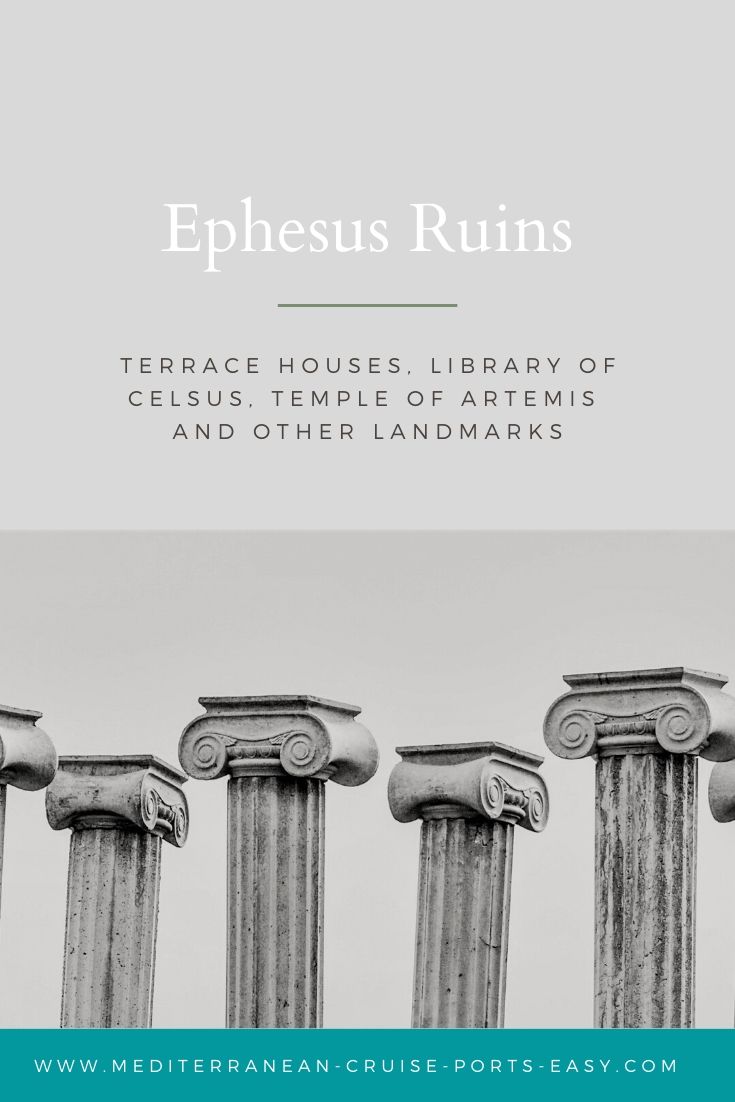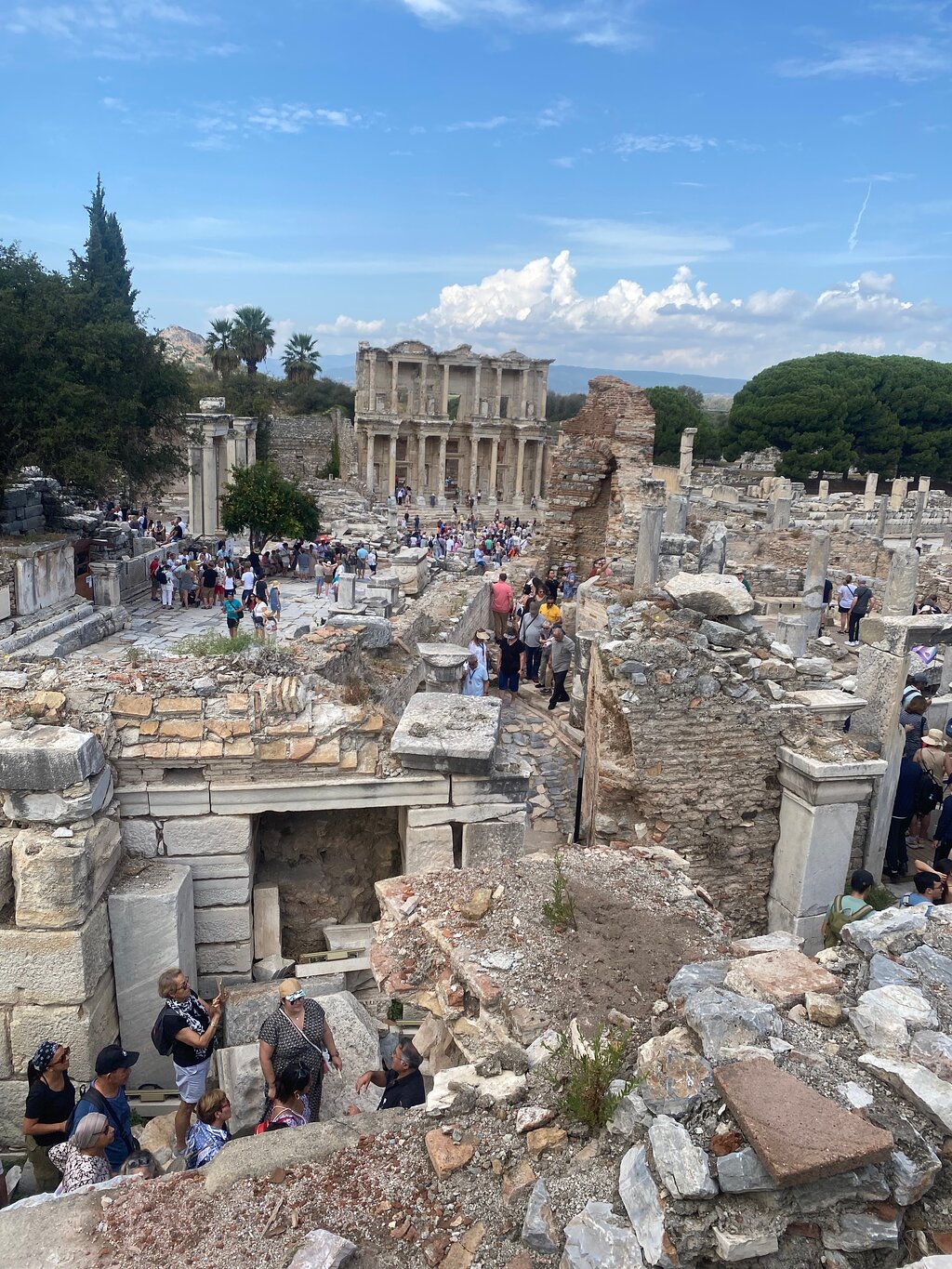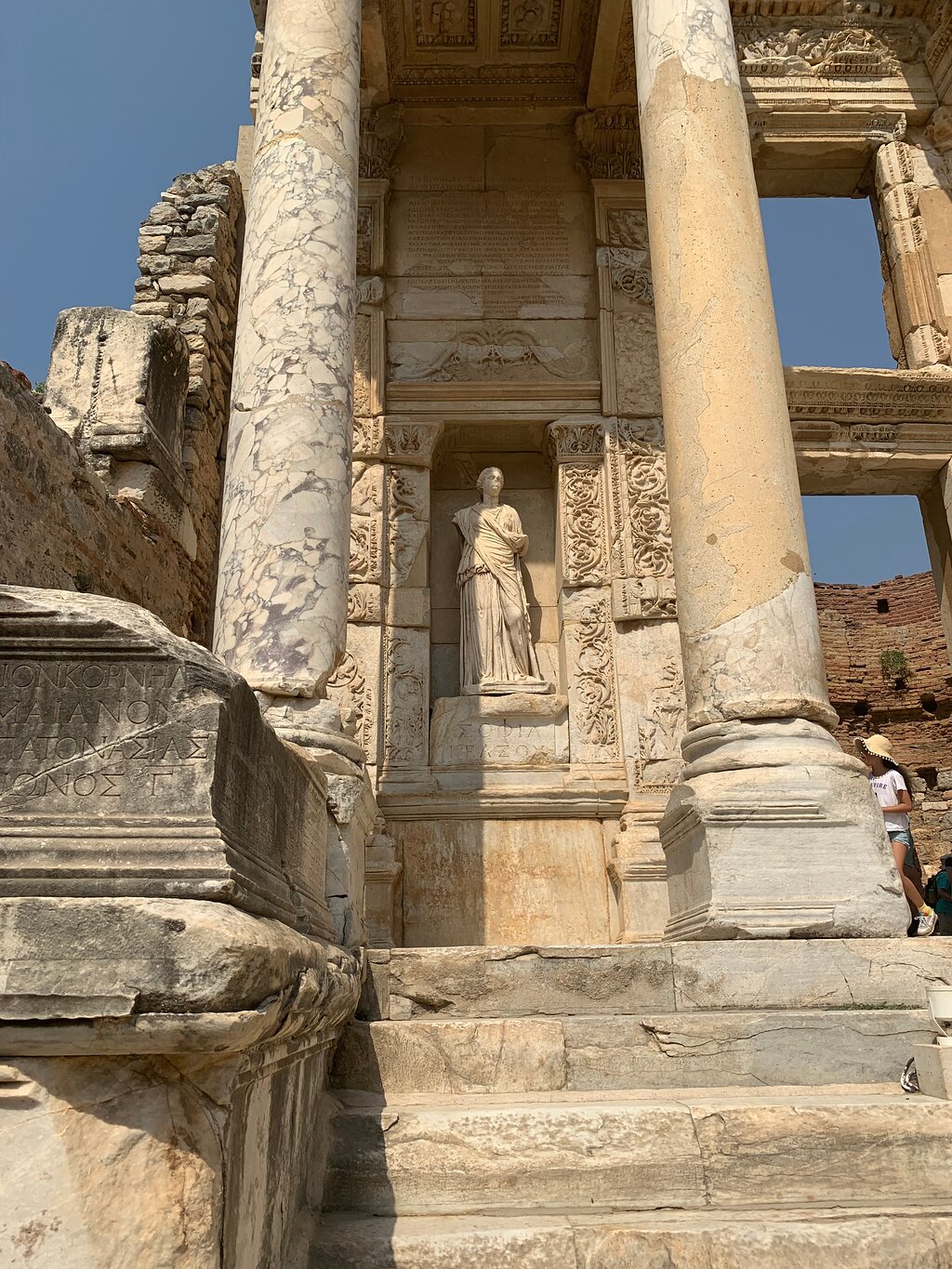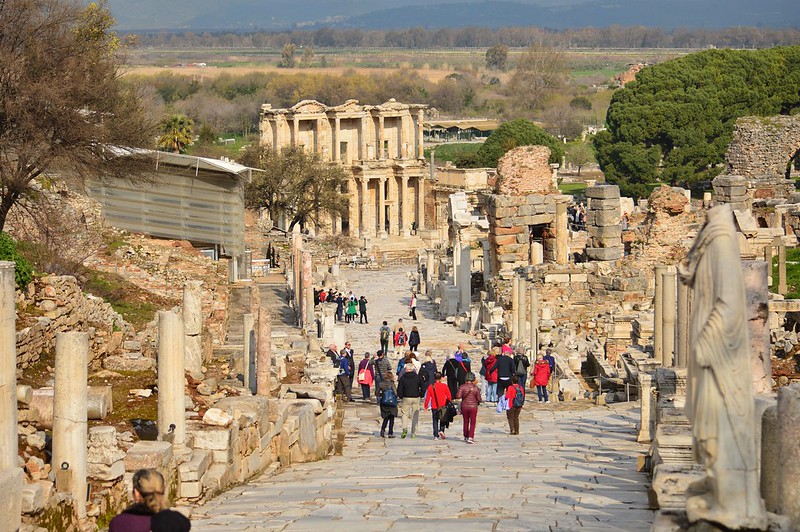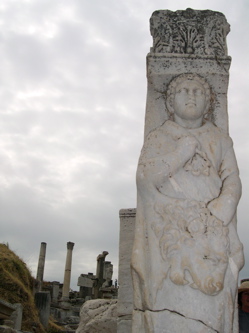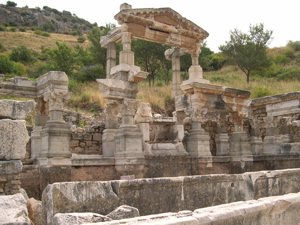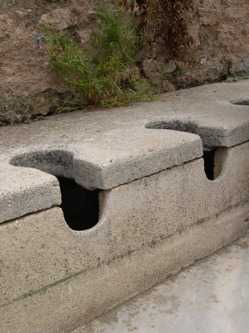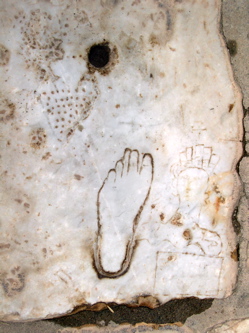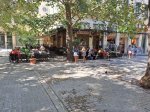Ephesus ruins -
Terrace Houses, Library of Celsus,
Temple of Artemis
Visiting the spectacular Ephesus Ruins is a must when you come to Kusadasi: find out where they are, why they are so special, what the entrance fees are and how to get there from the cruise ship
Get onboard a time machine!
Because to see and experience the Ephesus in Turkey is like travelling back in time.
You won’t need much imagination to really picture the way life used to be for Greeks and Romans a few millennia back when you walk the same pavements, look at the same facades, peek into their houses, sit in the same theatre they used to.
That is what’s so exciting about visiting this ancient city and why we say coming here is an absolute must for every Mediterranean cruiser when docking in Kusadasi harbour.
Take a look at what Steve Ricks says about this amazing archeological site...
Where are the ruins of Ephesus?
Ruins of Ephesus are located on the western shores of today's Turkey, some 50 km away from the modern day city of Izmir, 5km from the town of Selcuk and only 19km away from your crise ship and the harbour of Kusadasi.
That is why visiting Ephesus ruins is an absolute must, a once in a lifetime opportunity when docked in this port. Some cruisers come to the ship knowing this, others find it out onboard. Hopefully, not to late to book a tour of their preference as they do get sold out quickly.
Ephesus ruins map
On this Google map you can get the idea of how big the archeological site of Ephesus really is, as well as the position of the Celsus Library, Terrace houses and other landmarks of the site.
Ephesus ruins opening times
Every professional tour guide knows exactly what the opening times of Ephesus archeologic site are and will do his best to get you there before the sun gets too high and other tourists swarm the place.
At least Viator tour guides will as they take smaller groups and are more flexible.
Getting to Ephesus on your own is doable and you can read about different means of transportation to get there in my article Ephesus Travel. However, this is NOT the day to save on shore excursions! Read just a few reviews on Viator and you will know why :)
If you still decide to go on your own, here are the opening times:
Ephesus Ancient City/ Basilica of St. John/Archeological Museum of Ephesus
April - October: Opening Time: 8.00/Closing Time: 19.00
November - March: Opening Time: 8.00/Closing Time: 17.00
April - October: Opening Time: 8.00/ Closing Time: 18.30
November - March: Opening Time: 8.00/Closing Time: 16.30
January - February: Opening Time: 8.00/ Closing Time: 17.00
March - October: Opening Time: 8.00/ Closing Time: 18.00
November - December: Opening Time: 8.00/ Closing Time: 17.00
Ephesus ruins entrance fees:
When booking one of the Viator Ephesus shore excursions always check which locations on the site are included in the price.
Here's the entrance fees for all of them so you can plan ahead.
- Ephesus: 15 Euro per person (100 Turkish Lira)
- House of Mary: 7 Euro per person (45 Turkish Lira)
- Temple of Artemis: Free of Charge
- Sirince Village: Free of charge
- Isa Bey Mosque: Free of Charge
- Terrace Houses: 7 Euro per person (45 Turkish Lira)
- Basilica of St. John: 4 Euro per person (25 TL)
- Museum of Ephesus: 4 Euro per person (25 TL)
How old are the Ephesus ruins?
The very first Attic-Ionian (Greek) colony called Ephesus dates back to the 10th century B.C.
It was situated on the hill near the remains of the ancient Ephesus you can still see today. Those date back to the Greek and Roman era when the town most flourished.
What is Ephesus famous for?
Ephesus was one of the most important and wealthiest Greek cities and Mediterranean ports (that's right, the sea used to go all the way to Ephesus).
It was one of the members of Ionial League (a city-states alliance) during the classical Greek era.
It was home to one of the Seven Wonders of the Ancient World, the Temple of Artemis, a splendid Celsus Library, and a theatre that could hold up to 25,000 spectators.
It holds great importance for the development of early Christianity, too.
It was one of the seven churches of Asia mentioned in the Bible, this is where the Apostle Paul preached and John might have written his gospel.
Legend says the Virgin Mary ended her life here, too.
So many reasons to take one of the Ephesus daily tours and find out more stories about this amazing historic site from the knowledgeable and professional Turkish tour guides.
What is Ephesus called now?
In Turkish, this city is called Efes, just like the Turkish beer called after the ancient city. But it is still referred to as Ephesus by tour guides.
What is the best way to see Ephesus ruins?
Getting to Ephesus from your cruise port in Kusadasi on your own is possible and you can read all about it in Ephesus travel.
But no matter how you get there (either by a tour booked through your cruise line or individually online) make sure you have a professional tour guide by your side!
You could easily spend a few days exploring the Ephesus ruins by yourself and we know that as a cruise guest, you don’t have that much time.
That’s why a good guide will direct you to the most important attractions and most importantly, put them into perspective for you!
We know that tours on cruise lines get sold out quickly (and are more expensive than the ones booked independently) and that's why we have hand picked a selection of tours for you in our article Daily Ephesus tours.
Even if you are not the tour type of person, Ephesus is one of the ports you will be very happy you listened to my advice.
Viator shore excursions I wrote about are either private or take very small and intimate groups. With 5-6 cruise ships in Kusadasi port every single day, they do get booked up quickly. So do hurry up to avoid any disappointment!
Ready to book your tour now? Check out different types of tours at Daily Ephesus Tours.
21 top things to see and do in Ephesus
Here’s a list of some of the most attractive sights in and around the ruins of Ephesus city itself, so you get an idea of what you will be seeing:
1. The Varius Baths - One of the largest baths in the city, they date to the 1st Ct A.D. Note the “hypocaust” system for floor heating, some kind of Roman-time central heating.
2. The Temple of Artemis/Artemision -Unfortunately, today only one pillar remains of this once magnificent structure and one of the Seven Wonders of the ancient World. You can find out more about this ancient temple in our article The temple of Artemis at Ephesus.
3. Ephesus ruins: The Church of St. John/Basilica of St. John - This basilica is located some 3,5 km (2 miles) from Ephesus, on a hill near Selcuk. It has been built over the believed burial site of St. John, the author of the Gospel of John and the Revelations.
St. John came to the city in 42 A.D., together with Virgin Mary, to spread the word of Christianity.
In the 4th Ct, St. John’s grave was indicated with a small church with a wooden roof. It was only in the 6th Ct that Emperor Justinian built a magnificent basilica with a dome to mark the location of the Saint’s grave.
4. Odeum - Looking like a small theatre, this structure was built in the 2nd Ct A.D. This was where the members of the city council met the Curetes to decide on the future of the city. Its second function was for concert performances. This one of the Ephesus ruins could seat up to 15000 people.
5. The Temple of Domitian - Built in the 1st Ct A.D., this was probably the first building built in the name of an Emperor. Fragments of Domitian’s statue were found here and are now in the Ephesus museum.
6. The Heracles Gate - This gate was brought here from an older building at the end of the 4th Ct A.D. but was actually built in the 2nd ct.
Located at the end of the Curetes street, it got its name after the relief of Hercules with the skin of a Nemean lion.
7. The Curetes Street - This was one of the three main streets, stretching between the Hercules gate and the Celsus Library.
This one of the Ephesus ruins was named after the Roman-time priests dealing both with religious and state affairs.
The appearance of the street you can see today dates back to the 4th Ct A.D. The street was flanked by statues of famous Ephesians, fountains, stores and colonnades.
8. The Trajan Fountain - Built in the name of Emperor Trajan, at the beginning of the 2nd Ct A.D. There was a big statue of Trajan overlooking the pool, but only a foot remains from it today.
Around the pool there were columns and statues of Dionisus, Aphrodite, Satyr and the family of the Emperor.
Some of them are kept in the British Museum and others in the Ephesus Museum.
9. The Scholastica Baths - Like the other typical Roman baths, these have four divisions too.
They were built at the end of the 1st and the beginning of the 2nd Ct A.D.
They were named after the rich Christian lady Scholastica who renovated them in the 4th Ct A.D.
10. The Temple of Hadrian - Built in honour of the Roman Emperor Hadrian in the 2nd Ct A.D., this is one of the most beautiful structures on Curetes street.
You will recognize it by 4 Corinthian columns supporting a curved arch in the middle of which is a relief of the goddess of victory, Tyche. There are beautiful reliefs on both sides of the building.
11. Public Latrines - This tourist attraction of Ephesus was part of the Scholastica baths and dates to the 1st Ct A.D.
They were the actual public toilets of the city and still today you can see the U-shaped toilet openings aligned along the wall.
It could accommodate up to 50 people at a time!
12. The Houses on the Slopes/Terrace houses - These houses located on the slopes of a hill opposite Hadrian’s temple were the houses of the rich Ephesians.
Most of these Ephesus ruins date back to the 1st Ct A.D. They give us some valuable information of family life between the 1st and the 7th Ct A.D. when they were used.
You will have a chance to see some floor mosaics and frescoes here, as well as the “hypocaust” system of floor heating.
13. The Brothel - This structure consists of a number of rooms and halls around an atrium. A baked clay statue of God Bes with a huge phallus was found here.
14. The Celsus Library - Dedicated to the General Governor of the Asian Province, Tiberius Julius Celsus, this Ephesus library is one of the most beautiful structures in Ephesus.
It has a recognizable, two-storey façade with Corinthian style columns, restored between 1970 and 1978. That’s when the original statues of the four virtues (wisdom, knowledge, intelligence and valor) were replaced with the replicas you see standing in the niches today.
There were over 12000 scrolls kept here in cupboards in niches on the walls.
You can read about it more in our article Ephesus Library.
15. The State Agora - Built during the reign of Emperor Augustus and Claudius (1st Ct A.D).
This agora wasn’t used for commerce but is where the religious and state meetings were held. There was a temple of Isis in its center.
16. The Marble Road - Stretched between the Celsus Library and the Great theatre, the road was first constructed in the 1st Ct A.D. and then renovated in the Hellenistic period.
It was flanked with stoas serving as pedestrian sidewalks. It is on this road that the advert for the brothel can be seen.
17. The Grand Theatre - The grandiose structure of the Ephesus theatre was first constructed in the Hellenistic Period, in the 3rd Ct B.C., but it was enlarged in the 1st Ct A.D.
It could seat up to 25 000 spectators.
It was used for religious, philosophical and political discussions as well as animal and gladiator fights.
18. The Theatre Gymnasium - This is one of the complexes in Ephesus that was used for bathing and exercise.
It was mainly used by the theatre players, and that’s where its name comes from.
19. Arcadian way – The Harbour Street - This street extends between the Grand theatre and the harbour.
Coming from the port, it would be the first thing visitors would see, so it was lavishly decorated with marble and colonnades.
There are two monumental porticoes on both ends of the street. In the 6th Ct there were four big columns placed on this street holding the statues of the four apostles.
It is named after Emperor Arcadius.
20. The cave of the seven sleepers - According to Christian legend, in this grotto on Mount Pion near Ephesus, is where seven young men, who were prosecuted by emperor Decius in the 3rd Ct A.D., were walled in.
Three centuries later, the mouth of the cave was sealed off and the men were found inside… sleeping!
21. The House of the Virgin Mary - This site is hidden in the green of a mountain slope, some 9km away from Ephesus.
Virgin Mary is said to have come to Ephesus with St. John to spread the word of Christianity.
This used to be a typical Roman house, which was later built into a shrine. There are fountains by the house that are believed to have healing properties.
- Home
- Kusadasi Tours for Cruisers
- Ephesus Ruins
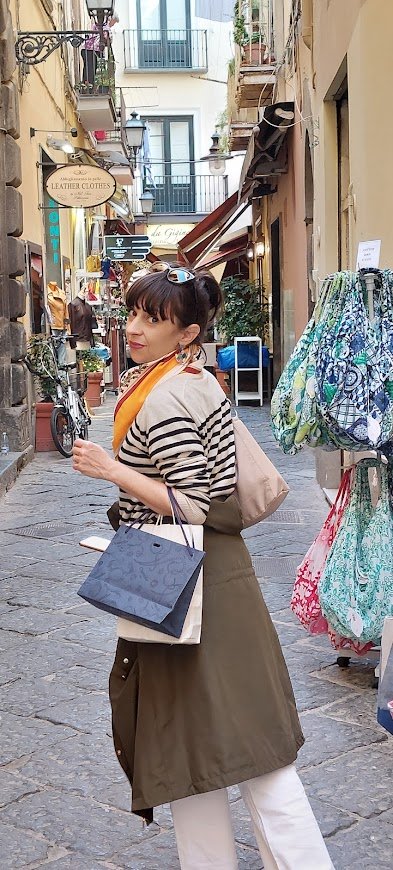
With over seven years working aboard cruise ships as a port guide and shopper assistant, I’ve helped thousands of passengers get the best from their days ashore in Dubrovnik. Now, I want to make you Med confident!
TAKE A SHORTCUT TO TOP 30 MOST VIEWED PAGES OF 2025:
4. Capri ferry
10. Livorno Italy
13. Naples to Capri
16. Messina Sicily
17. Pisa Train
18. Visiting Pompeii
19. Pompeii forum
20. Port of Piraeus
22. Venice vaporetto
23. Venice water bus
24. Livorno map
25. Getting to Zadar
27. Walk Venice
28. Mykonos beach
29. Lucca Italy
30. Pomepii homes
